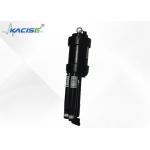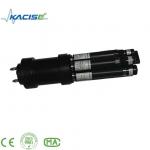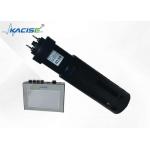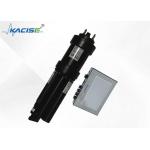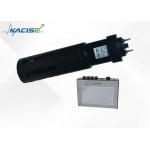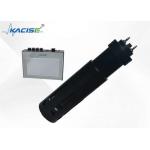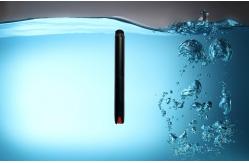Online Ammonia Nitrogen Sensor RS485 Modbus Convenient To PLC DCS
KAN310 integrated on-line ammonia-nitrogen sensor is made of
ammonium ion selective electrode based on PVC membrane, which is
used to measure the content of ammonium ion in water with
temperature compensation.
2.Feature
- Signal Output: RS-485 bus, Modbus/RTU protocol,
- Convenient to connect to PLC, DCS, Industrial Control Computer,
General Controller, paperless recording instrument or touch screen
and other third-party equipment.
- The patented ammonium ion probe, with an internal reference fluid
at a pressure of at least 100 kpa (1 bar), oozes extremely slowly
from the microporous salt bridge. Such a reference system is very
stable and the electrode life is longer than ordinary industrial
electrode life.
- Easy to install: submerged installation.
- Ip68, containment level.
| Model Number | KAN310 |
| Range | 0 ~ 10.00 mg/L (0 ~ 100.00 mg/L) |
| Resolution | 0.01 MGL |
| Precision | ± 10% or ± 1MG/L |
| Operating Temperature | 0 ~ 40 °C |
| Working Pressure | < 0.1 mpa |
| The Ph Range Of The Medium | 4 ~ 10ph |
| Temperature Compensation | Automatic temperature compensation (PT1000) |
| Power Supply | 12 ~ 24 VDC ± 10% |
| Signal Output | RS-485 bus, Modbus/RTU protocol |
| Contact Material | PVC and POM |
| Installation Mode | Immersion mounting |
| Cable Length | 5 meters, other length can be customized |
| Calibration Mode | Two-point calibration |
| Power Consumption | < 0.05 W |
| Protection Level | IP68 |
Tip:Why are ammonia and nitrate monitoring so critical?
Carbon, nitrogen, and phosphorus are the building blocks of life
and components of municipal wastewater.
Wastewater treatment transforms or removes these components to
prevent over-enrichment of receiving waters and undesirable
effects. Ammonia, nitrite, nitrate, and organic nitrogen are forms
of nitrogen in wastewater.
For instance, ammonia is acutely toxic to aquatic organisms and so
discharge permits nationwide include requirements to limit the
concentration in treated wastewater. Requirements to limit total
nitrogen (TN), including nitrate, address a chronic issue of
nutrient over-enrichment which can lead to harmful algae blooms.
Laboratory measurement of grab or composite samples is the dominant
method.
